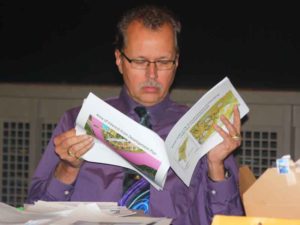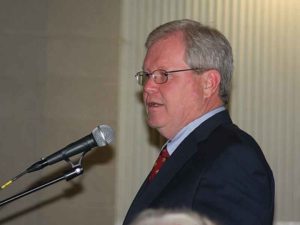Commission delays decision on Woodlawn Springs golf course redevelopment

ABOVE: The blue areas on this aerial view of Woodlawn Springs are parts of the golf course its owners wish to redevelop as new residential areas.
By JIM BROOKS
Nelson County Gazette / WBRT Radio
Tuesday, Dec. 12, 2017 — At the end of nearly four hours of testimony, the Joint City-County Planning Commission decided to delay making a decision on a requested development use change that would allow the owners of the 140-acre Woodlawn Springs golf course to redevelop the property for a mix of residential housing.
The golf course is owned by Christopher J. Osborne, Allison Osborne and James A. Osborne through their Woodlawn Springs Golf Club limited liability corporation. According to Jim Willett, the Bardstown attorney who represented them at the hearing, the family has owned the golf course since 2004.
The golf course has not been profitable for quite some time, Willett explained, and the owners want to develop the golf course into housing units of a similar quality as exist in the Woodlawn Springs subdivision.
The zoning amendment application is the first step in the process.
Despite a plan showing new streets and lots platted where the golf course exists, Willett told the crowd that the development plan submitted was very preliminary step in land use planning, and subject to change along the way.
“It is common procedure that this application will be followed by other aspects of land use planning and development.” Those include an engineering analysis of property’s geology and topography, traffic considerations, and other required reviews before the project can move forward to the next step.

Council Drive resident Tracey Wangler expresses her concerns during a public hearing Tuesday at the Bardstown High School auditorium.
But concerns about that “next step” for the property brought dozens of residents of Woodlawn Springs and the Gardens of Woodlawn to the hearing. Those who spoke were against the plan to turn the golf course into additional residential housing.
There were concerns voiced about how the redevelopment would impact the value of their homes that neighbor the golf course, and the loss of the open, green spaces that made the development so attractive. Several residents said the development’s green space was what attracted them to purchase a home there.
Drainage is an issue already in sections of the surrounding neighborhoods, and residents voiced concerns that turning the golf course into additional streets and driveways would make drainage problems worse.
Others voiced concerns about the new homes adding to traffic problems on Woodlawn Road. Several mentioned the multitude of accidents that already happen on Woodlawn Road, particularly in the area of the road known as the “S curves.”
Mount Washington attorney Mark Edison represented the Woodlawn Springs Homeowners Association, and argued that the proposed redevelopment of the golf course failed to meet the standards in the county’s comprehensive plan.
He questioned the availability of sufficient water, sewer and drainage to serve the new homes.

Planning commission member Charles Howard reviews one of the exhibits presented during Tuesday’s public hearing regarding plans to redevelop the Woodlawn Springs subdivision into new residential development.
Twin Oaks Drive resident James Washburn presented the commission with an exhibit that included geological maps with locations of sink holes in the Woodlawn Springs area. Three sink holes are identified on the proposed development plan and are currently maintained as part of the golf course.
But Washburn’s map showed six additional sink holes, some of which were located in areas where new roads and homes are proposed on the existing golf course.
“The point I’m making is there’s a reason the golf course is where its at,” he said, referencing the location of the sinkholes. “The depressions and slumps make it a challenging golf course, but they don’t make for a good place to build a neighborhood.”
In answer to the proposal’s critics, Willett called most of the comments against the application “largely irrelevant.”
Sink holes can be mitigated, he explained. Concerns about the homes, traffic, drainage and other issues would be addressed once the property is evaluated and the next steps in developing the property begin.
As the testimony finished the commission members spoke briefly about the application before they voted to table the application and take it up again at the next regular planning commission meeting, 6 p.m. Jan. 23, 2018.
-30-







